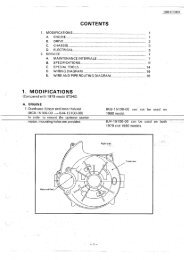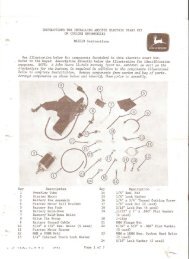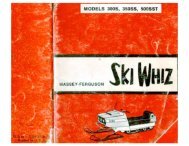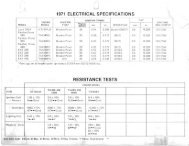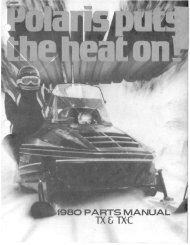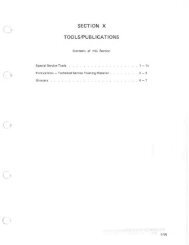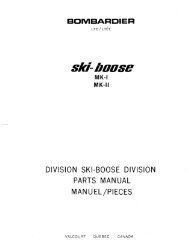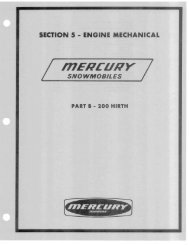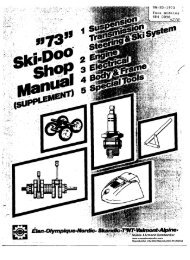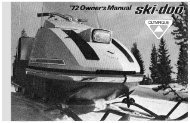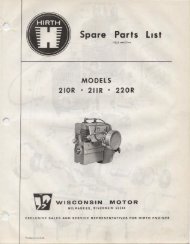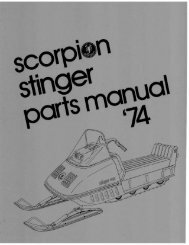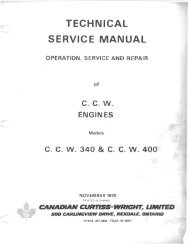You also want an ePaper? Increase the reach of your titles
YUMPU automatically turns print PDFs into web optimized ePapers that Google loves.
ENGINE ELECTRICALAlternator Controlled Switch "ACS"Shown is the (ACS) for the 1993 to current 500 EFIsystems. The ACS controls voltage from thealternator by rectifying from AC to DC voltage currentto charge the battery. It also supplies the ECU with a12vDC battery voltage signal to indicate that the<strong>engine</strong>'s crankshaft is turning. The ACS eliminatesthe need for the "Ready" light system reset as used onprevious 500 EFI models. NOTE: Even if the keyswitch and kill switch are in the "off' position, the ACSwill power up the system if the crankshaft is turned.(See also page 4.40, Power up testing.)Test ProcedureWith ignition in the on or run position, crank <strong>engine</strong> over slowly. You will hear the fuel pump run for approximatelyfive seconds. This tells you the ACS is working. If the fuel pump doesn't work when cranking, disconnect ECUwire harness and reconnect to reset ECU. Crank <strong>engine</strong> again. If fuel pump won't start working, unplug theharness at the ECU and check Orange/Black wire PIN #11 on the ECU harness. Battery voltage should bepresent when cranking <strong>engine</strong>. NOTE: You can also use the select monitor to determine if the ECU is gettingpower. If the select monitor display lights up, then the ECU is getting power, check the ACS wire at the ECU plug.CAUTION: Take care not to distort the pin with your tester lead. If no voltage is present, reset ECU and checkOrange/Black lead at ACS unit. If no voltage is present, check for alternator output or loose connections. Ifalternator output is OK, replace ACS.NOTE: 1994 to current sao's will use a five wire ACS LR36. The extra wire is for a center tap alternator.\Cold StartingWhenever the <strong>engine</strong> is being cold started, the ECU will select a special "start-up" mode. This will occur any timethe <strong>engine</strong> is being cold started; for example, any Type I system which has been "key off' long enough for the selfshut-off timer to power down the system, or a Type II system which has had the <strong>engine</strong> stopped long enough forthe ready light to go off. After turning on the ignition key to reset the system, the fuel pump will run from three to fiveseconds to pressurize the system. When the ECU sees the first ignition pulse it provides a longer than normal"prime" pulse to the injectors to inject enough fuel into the <strong>engine</strong> for starting. On 1993 and later Type II systems,there is no ready light or ignition key reset. The pump mayor may not run for the 3-5 second period depending onhow long the <strong>engine</strong> has been off. In all systems, the "prime" pulse only occurs if the pump runs for the 3-5 secondperiod.Once the <strong>engine</strong> is running the ECU provides a rich cold <strong>engine</strong> mixture while the <strong>engine</strong> is warming up. It uses the<strong>engine</strong> temperature sensors as an indicator of when the <strong>engine</strong> is warm enough to start decreasing the fuel to airratio. If the key is turned off, the ECU provides power to the self shut-off relay for from ten seconds to ten minutes,depending upon the system type, and will not repeat the fuel system pressurizing and prime pulse during that time.Once the self shut-off sequence has expired, the <strong>engine</strong> will have had sufficient time to cool and the ECU will againrepeat the cold start sequence.In Type I systems only, during times of severely hard running or in very warm weather if the <strong>engine</strong> crankcaseshould approach a temperature which might result in <strong>engine</strong> damage the ECU will provide additional fuel to the<strong>engine</strong> for cooling. When the crankcase temperature sensor indicates a temperature of approximately 100°C, theECU will lengthen the pulse time and cause an over-rich condition which will cool the <strong>engine</strong>. As soon as the<strong>engine</strong> temperature returns to normal, the ECU will return to the original map.If the <strong>engine</strong> should become flooded during starting, it can be cleaned out by holding the throttle wide open whileturning the <strong>engine</strong> over. If the <strong>engine</strong> is not running, and the throttle is open more than 60°, no fuel will be injected.The <strong>engine</strong> will start and will begin receiving fuel from injection when the <strong>engine</strong> exceeds 800 RPM, or when thethrottle position goes under 60°. The <strong>engine</strong> should then clean out and run normally.In Type II systems, the <strong>engine</strong> is protected against overheating by the <strong>engine</strong> coolant sensor. If the <strong>engine</strong> coolantreaches a threshold (<strong>85</strong>°C 1993 and later, else 1 OO °G) the 'temp" light on the dash will begin to flash. If the <strong>engine</strong>coolant temperature continues to increase, the light will begin to blink faster. When the light blinks fast, the ECUadds fuel to enrich the mixture and to help prevent <strong>engine</strong> damage. The fuel will continue to be added until the lightstops blinking.8/94 4.42



